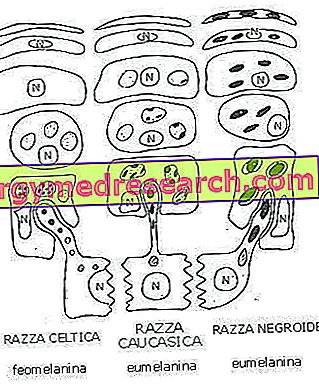Generality
The spider bite is a lesion that results from the close encounter with an arachnid.

For man, this occurrence is completely accidental and occurs when the spider is inadvertently touched or crushed.
In most cases, the effects are not serious: the spider bite generally causes mild disorders, similar to those of insect bites, that is an irritation with redness and swelling. Less often, severe local pain, systemic toxicity or allergic reactions may occur. Rarely, the skin wound can become necrotic.
The spider bite regresses without particular treatment, relatively quickly, except in cases where complications of medical importance are required.
If the lesion does not cause too intense symptoms, to limit the discomforts it is possible to carry out simple first aid maneuvers (eg application of ice, rest and raising of the limb). In the event that a more severe reaction develops (allergy or systemic toxicity) after a spider bite, it is advisable to request immediate medical intervention.
What's this
The spider bite is a lesion, also known as arachnidism, which can occur when the arachnid finds itself in close contact with the victim's skin.
Man is not among the potential prey of these animals, which tend to hide in their shelters or to run away when disturbed. Almost all the bites inflicted on man occur when the spider is inadvertently stepped on barefoot or a hand is introduced into a garment or between the sheets, where the animal is hidden.
Although 98-99% of spider bites are harmless, it should be noted that, in the remaining cases, this event involves necrotic wounds, systemic toxicity and, more rarely, death .
Causes
The buccal apparatus of the spider is designed to inject the poison into the victims, usually insects and small animals, in order to immobilize or kill them, before feeding on them.
It is not customary for arachnid to bite humans, even if this can happen, especially when it is trapped in the palm of the hand or is seriously annoyed. In any case, it is the toxicity of the poison that poses the greatest risks for humans .
Types of spider bites
The spider bite can occur by attack or defense, depending on whether the arachnid is attacking a prey to eat it or is perceiving a threat .
Normally, spiders do not attack humans or large mammals, as they are not considered prey. Almost all of the bites inflicted on them are defensive . Sometimes, the spider does not even inoculate the poison and, in this case, it is called " dry bite ", literally " dry bite ", since they have the sole purpose of removing the person .
Spider bite: poison
Spiders have no teeth, but have two chelicerae, each consisting of two segments:
- Fang (or sting) : it is sharp and sharp, to penetrate deep into the skin, the fur or the exoskeleton of the prey.
- Basal portion : includes poison glands and the constricting muscles that surround them; the latter are voluntarily contracted by the spider to cause the poison to escape, which through the tusks will be injected into the wound caused by the bite.

During the bite, the spider can control the amount of poison inoculated in the victim and can adjust the dose according to the circumstances. In fact, for arachnid, producing poison has a significant cost in terms of energy. Also for this reason, spider bites to humans are often devoid of poison ("dry bite"): the arachnid attacks only as a last resort, if it has no other choice.
The venom inoculated by spiders can be neurotoxic (it attacks the nervous system, inducing paralysis of the prey) or necrotoxic (it affects internal organs and tissues around the wound, triggering a partial digestion of the involved part).
Spider bite towards OTHER ANIMALS. In nature, the spider is a predator that feeds mainly on other arthropods (insects, other spiders, myriapods, mites, etc.). The bite is, therefore, a means of overcoming its own prey: the arachnid inoculates a poison with which it immobilizes or kills the victim, before eating it. Although the bite and the possible injection of poison are also used for defense, therefore, these means represent the main way in which the spider gets the food.
MAN spider bite. As for humans, the effects of the poison inoculated in the wound during the bite is the most significant element in the medical field. Some spiders are considered to be very dangerous precisely because they possess poisons that are particularly harmful to humans, even in the small amount that can be injected with a single bite. Fortunately, not all spider bites involve poison inoculation.
Dangerous spiders in Italy
In the world, the spider species considered dangerous for humans are about 200 (out of over 42, 000 of those existing); among these, there are potentially lethal arachnids, such as the banana spider or the black widow.
In Italy, the species whose bite is of medical importance to humans are mainly three:
- Malmignatta ( Latrodectus tredecimguttatus ) : also known as Falangio di Volterra, it is recognizable by its rounded body and the presence of the characteristic red dots on its black back. In our country, L. tredecimguttatus is present in the Mediterranean regions, between the low vegetation of the woods and the scarcely frequented ruderal areas. This arachnid produces very resistant irregularly shaped cobwebs and usually does not nest inside the houses.
- Violin spider ( Loxosceles rufescens ): also known as a hermit spider, it has a body of 7-9 mm, of a yellowish-brown color, with long legs. This species is widespread throughout the world; in Italy, it is present mainly in the Mediterranean area. The violin spider is a nocturnal animal; during the day, it remains holed up in crevices and fissures. In homes, this arachnid prefers dark and sheltered environments (behind furniture, skirting boards, under cardboard boxes or even inside gloves, shoes, floors and basements, etc.).
- Tarantula ( Lycosa tarentula ): it is found above all in the central and southern areas of Italy; it causes a very evident, swollen and bluish-colored puncture. However, the bite of this spider is less dangerous than that of the violin spider and does not cause fatal reactions. The body of most tarantulas is covered with black and brown hair, but some species show more vivid colors. These spiders prefer to live in dry soils where they dig a den which they then carpet with their web.
Symptoms and Complications
The severity of the spider bite depends on the species of arachnid one came into contact with and the dose of inoculated venom.
In the affected area, the common consequences include:
- Burning pain in the bite site;
- Redness ;
- Swelling ;
- Decrease in sensitivity .
These symptoms generally start after 2-6 hours (often, the spider bite is not immediately felt) and involve only the area around the lesion. Usually, the manifestations tend to worsen gradually in the 24 hours following the contact with arachnid, but, in most cases, they are self-limiting and harmless .
Only in some cases, the local manifestations of the spider bite can be associated with systemic symptoms, including: malaise, nausea, fever, headache-and-dizziness, fever, sweating and a widespread and itchy skin rash.
Systemic symptoms generally subside in 24-48 hours, while local symptoms in a few days.
Bite of the violin spider
The bite of the violin spider is initially painless and no alterations are evident in the affected area. In the following hours, a lesion reddened with itching, burning and tingling begins to appear; within the next 48-72 hours, the wound can become ulcerated, giving rise to necrosis and eschar of tissues that are located near the bite (cutaneous loxoscelism).
Bite toxic reaction
Spider bite with inoculation of necrotoxic venom can induce a systemic reaction, which is manifested by:
- Nausea, vomiting and abdominal pain;
- Joint and muscle pains;
- High fever;
- Hemolysis (rupture of red blood cells);
- Platelet reduction.
This type of poison is possessed by the violin spider and the malmignatta.
The inoculation of the neutotoxic venom with the spider bite can induce:
- Restlessness;
- Insomnia;
- Spasms and muscle cramps;
- Breathing difficulties.
In the most serious cases, the toxic reaction to the spider bite can induce:
- Weakness;
- Cardiac arrhythmias;
- Hypertensive crisis;
- Lymph node pain;
- Pharyngitis;
- Abundant salivation (sialorrhea);
- Disorientation, confusion and loss of consciousness.
Spider bite allergy
In previously sensitized people, the spider bite can induce a local allergic reaction, characterized by erythema, extensive edema and pain.
Other times, the allergic reaction to the spider bite can involve different parts of the body and induce systemic manifestations, including: generalized urticaria, angioedema, respiratory difficulties, palpitations, feeling of nausea and abdominal cramps.
In severe cases, an anaphylactic shock may develop after a spider bite. This is characterized by a marked and persistent reduction in arterial pressure, which can lead to numbness or loss of consciousness, dizziness and cardiovascular arrest.
Possible complications
- In addition to the poison inoculation, the spider bite can carry anaerobic bacteria into the tissues which, as they develop, complicate the course of the lesion with possible progressive necrotizing fasciitis .
- In the most severe cases, the general reaction to the spider bite can get complicated with difficulty breathing, bleeding, kidney failure and liver damage.
Diagnosis
The diagnosis of the spider bite is clinical: the doctor first checks the skin area involved, in order to identify any signs of allergic reaction, toxicity or necrosis.
Alarm signals
Some symptoms associated with spider bites must be interpreted as alarm bells. The sudden onset of these manifestations or their progressive worsening, must induce to consult the doctor within a short time :
- The area of the spider bite is sore, red, hot, swollen and surrounded by a pale halo, red-bluish or purplish;
- At the site of the lesion and in the neighboring tissues, itching, changes in sensitivity and crusts of dark color (eschar) appear;
- After the spider bite, systemic symptoms begin, such as nausea, vomiting, muscle weakness or fever.
Treatment and Remedies
Most spider bites are not dangerous and regress without special treatment. The medical intervention is appropriate, instead, if allergic reactions and necrosis of the wound take over.
In any case, the spider's bite should never be underestimated.
What to do in the event of a spider bite?
In mild cases of spider bite, it is useful to rest, compress and keep the affected part raised (when the limbs are involved).
Non-necrotic forms can be relieved by the application of cold compresses or the immersion of the affected area in fresh water to relieve the pain or discomfort associated with spider bites. The ideal would be to have available a first aid kit, equipped with ice that can be activated instantly (you can buy it at the pharmacy, parapharmacy or at the supermarket).
In general, then, it is useful:
- Do not manipulate or engrave the site of the spider bite;
- Wash the wound thoroughly with soap and water;
- Do not apply aggressive disinfectants;
- Pay attention to the appearance of symptoms, even if initially the spider bite was not felt (possibly documenting the lesion with a series of photographs, to monitor the evolution).
When the symptoms of the spider bite tend to persist, however, it is always necessary to consult the doctor, who can indicate the use of analgesics (to reduce the strong pain symptoms) or the application of cortisone-based creams (to reduce itching and inflammation). Depending on the case, it may also be useful to use antihistamine lotions, antibiotics, NSAIDs, lidocaine patches or other topical anesthetics.
If the symptoms of a spider bite appear serious immediately, instead, call 118 or contact a poison control center. Depending on the type of spider that caused the bite, in fact, it may be necessary to administer a specific antidote, capable of blocking the action of the toxin. For moderate to severe wounds, surgery may be required.
Warning! If it is possible, capture the spider and store it in a closed jar, take it to the emergency room for recognition. Even if crushed or trampled, the arachnid can be identified.
Prevention
Before biting, the spider assumes a typical attacking position, in front of which it is still time to retreat.
How to protect yourself from a spider bite?
The adoption of certain behaviors can help to minimize the risk of being bitten by a spider. First of all, the removal of these animals is done by direct capture or by suction with commonly used appliances . Instead, chemical disinfestation techniques should only be used as a last resort.
In general, to prevent the spider bite it is good to observe the following precautions:
- Always use caution when removing a spider's web, using a broom with the long handle;
- Avoid touching or manipulating spiders with bare hands;
- Wear suitable gloves and footwear in case of risky activities (gardening, cutting or collecting wood, tidying up old boxes, domestic cleaning etc.).



